
|
|
June 5-12, 2002
A Quick Jaunt Through Birmingham, Alabama
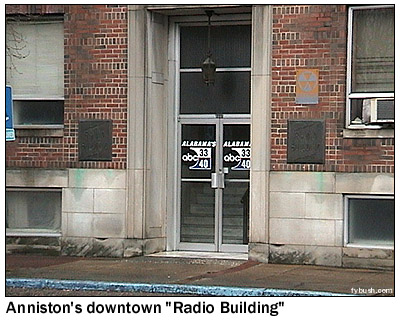 When we left you
last week, we were driving west on I-20, through a heavy March
rainstorm that made the trip from Atlanta to Birmingham a soggy,
gray experience.
When we left you
last week, we were driving west on I-20, through a heavy March
rainstorm that made the trip from Atlanta to Birmingham a soggy,
gray experience.
But before we get to Alabama's biggest city in the rain, a quick detour to a city that's drawn the short end of the move-in straw twice in the last few years. We speak of Anniston, a pleasant little town that has the misfortune of being 90 miles west of Atlanta and 65 miles east of Birmingham.
And that, in turn, has made Anniston's FM and TV allocations fair game for poaching by move-in operators on both sides.
On the FM side, Anniston had a nice, big 100 kW signal, WHMA-FM, at 100.5.
That's "had," as in past tense, because after years of trying, the allocation was moved to College Park, Georgia, last year. "College Park"? Yeah, OK - that's really "Atlanta" to everyone but the FCC; even the transmitter is now right in the heart of downtown Atlanta, atop the Westin Hotel we showed you last week; the station is now Susquehanna CHR WWWQ "Q100."
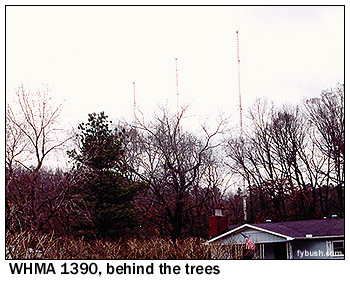 (And Anniston made
out worse this time than in the original, late-80s plan to move
WHMA-FM to Atlanta; that plan would have put 100.5 in Sandy Springs,
Georgia, but allocated a new 100.1A to Anniston. This time around,
Anniston got nothing!)
(And Anniston made
out worse this time than in the original, late-80s plan to move
WHMA-FM to Atlanta; that plan would have put 100.5 in Sandy Springs,
Georgia, but allocated a new 100.1A to Anniston. This time around,
Anniston got nothing!)
The former WHMA-TV, once a CBS affiliate on channel 40, is now WJSU-TV. It's still licensed to Anniston, at least, but look at that logo in the picture above: it's half of a two-station Birmingham rimshot ABC affiliate that goes by "Alabama's ABC 33/40." The other half, WCFT-TV in Tuscaloosa, is 58 miles on the other side of Birmingham; it too used to be a CBS affiliate, and Tuscaloosa and Anniston used to be separate markets. Today, they're part of a huge "Birmingham" TV market that stretches from the Georgia line almost to Mississippi, and Anniston viewers seeking local news have to be satisfied with a quick cut-in from the old WHMA "Radio Building" downtown.
Our stop in Anniston was brief, just long enough to see what's left of local radio in town, which mainly consists of WHMA(AM), still going strong on 1390 from that three-tower array shown here. It's north of downtown by a few miles; on the way back in, we passed the two graveyarders in town, WANA on 1490 and WDNG on 1450 (which was having some serious automation problems, with plenty of dead air and what sounded like a remote broadcast that just wasn't working!)
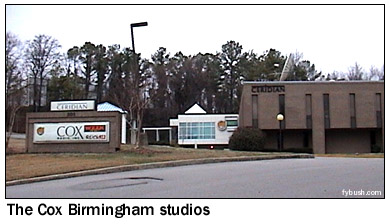 An hour later, and
we were in Birmingham, meeting up with Troy Pennington, the president
of the Society of Broadcast Engineers, for a tour of his stations,
half of the market's big Cox cluster. The building at right is
home to country giant WZZK (104.7), oldies WODL (97.3 Homewood)
and 80s WBPT (106.9 "The Point") - and they were all
running live and local that Saturday afternoon!
An hour later, and
we were in Birmingham, meeting up with Troy Pennington, the president
of the Society of Broadcast Engineers, for a tour of his stations,
half of the market's big Cox cluster. The building at right is
home to country giant WZZK (104.7), oldies WODL (97.3 Homewood)
and 80s WBPT (106.9 "The Point") - and they were all
running live and local that Saturday afternoon!
Joined by fellow radio aficionado Chris Cuomo, we headed around Red Mountain for some amazing ribs at the Dreamland Barbecue, then back around the mountain to see everything else (in addition to those Cox studios) that crowns the top.
Red Mountain is actually more of a ridge, slicing up to the southeast of downtown Birmingham, with newer suburban areas lining its western flank. It's a perfect location for towers, so it's no surprise that just about all of the major FM and TV stations in the market can be found up there. We began our tour about halfway along the ridge, at the Goldencrest Drive studio and transmitter of CBS affiliate WIAT (Channel 42). WIAT used to be WBMG-TV, one of three little UHF CBS affiliates in the region (remember WCFT and WHMA-TV?), and for many years, it had no local news. Today, it's the lone CBS affiliate for the expanded market, and it does a fast-paced newscast without on-air reporters.
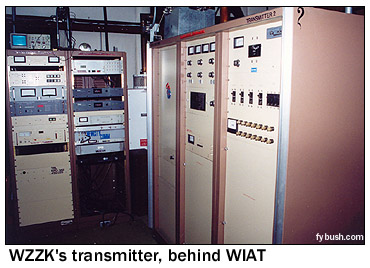
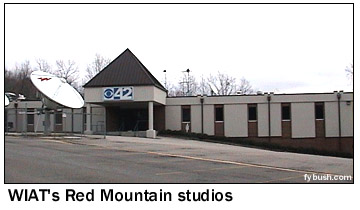
We're here to see what's behind WIAT: the little metal building where Troy's WZZK transmitters sit. And it's a good thing we came up here; for some reason, they've been running on generator power all day, so our visit gives Troy a chance to switch them back to "shore power" and shut off the generators. WZZK will soon be moving, joining WBPT at a new tower being built just up the road from WIAT. (We'll see that in a moment!)
Next door to WIAT is a smaller building marked "WPXH-TV 44." This is the Pax affiliate for the market, and while it located its offices with the rest of the TV crowd on Red Mountain, the Gadsden-licensed station transmits from a tower some 50 miles away, to the northeast.
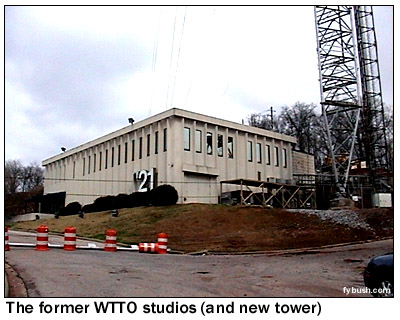 Up at
the top of Goldencrest, we find two tall towers: one that's home
to WTTO (Channel 21), the former Fox affiliate in the market,
now WB, and a new tower next door that will eventually carry
WTTO, WZZK and WBPT.
Up at
the top of Goldencrest, we find two tall towers: one that's home
to WTTO (Channel 21), the former Fox affiliate in the market,
now WB, and a new tower next door that will eventually carry
WTTO, WZZK and WBPT.
The building at the base of the tower was once home to WTTO's offices; today, those are near the Cox studios, a mile or so away on Beacon Parkway. (WTTO is simulcast on WDBB, channel 17, which is licensed to suburban Bessemer but transmits from a site near WCFT-TV, some 35 miles west of town; it's in an LMA with UPN affiliate WABM, channel 68.)
A shorter tower nearby is home to religious stations WBFR (88.5) and WGIB (91.9).
There's a second cluster of Red Mountain sticks southwest of here, across the cut where I-65 crosses the ridge; it's home to WABM's channel 68 transmitter, FM stations WDJC (93.7), WMJJ (96.5), WODL (97.3) and WZRR (99.5) - and a station called WBMA-LP on channel 58, which is the Birmingham relay of that ABC double rimshotter, "ABC 33/40" from Tuscaloosa and Anniston. How did ABC end up there? Let's look at the oldest part of Red Mountain for an explanation...
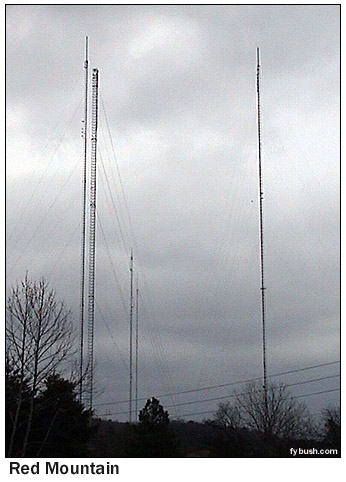 Our broad view of
Red Mountain's big towers was shot from the southeast, not far
from the Beacon Parkway studios of Cox, WTTO/WABM and the Clear
Channel cluster in town. On the left are WTTO (with WBHK 98.7
side-mounted) and the under-construction WTTO/WZZK/WBPT tower);
at right is WIAT, with WZZK side-mounted.
Our broad view of
Red Mountain's big towers was shot from the southeast, not far
from the Beacon Parkway studios of Cox, WTTO/WABM and the Clear
Channel cluster in town. On the left are WTTO (with WBHK 98.7
side-mounted) and the under-construction WTTO/WZZK/WBPT tower);
at right is WIAT, with WZZK side-mounted.
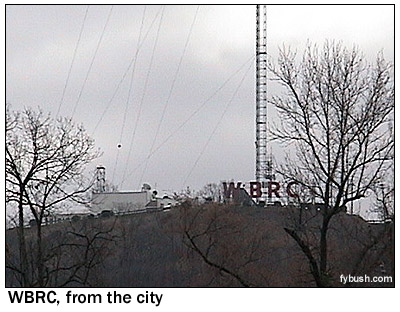
And in the middle, in the distance, are two more towers. On the left is WBRC-TV, channel 6, Birmingham's second TV station. Side-mounted on that tower are PBS outlet WBIQ (channel 10), public radio WBHM (90.3) and WBPT (106.9), the onetime WBRC-FM. Just beyond WBRC, to the right, is NBC affiliate WVTM, channel 13, with WYSF (94.5) mounted below.
WBRC signed on from here in 1949, with NBC and DuMont programming on channel 4; it moved to channel 6 in 1953 and picked up CBS the following year. In 1961, WBRC became an ABC affiliate, and held on to the network until 1996 - when the station wound up in the hands of Fox Television Stations, which flipped it to the Fox affiliation it holds today. Can you name another station that's been a primary affiliate of five different networks? We can't...
(WBRC's 1996 flip left ABC without a Birmingham home, and rather than affiliate with the former Fox affiliate, WTTO, the network hooked up with Allbritton Communications, which bought WCFT and WJSU, put WBMA-LP on the air and gave the city what's turned into a fairly successful new station, expanding the market for everyone else in the process.)
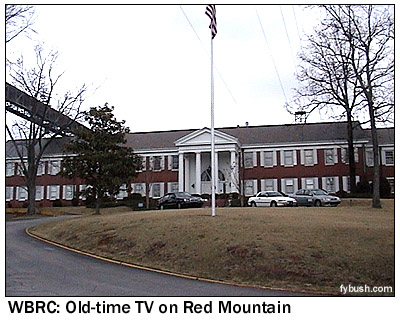
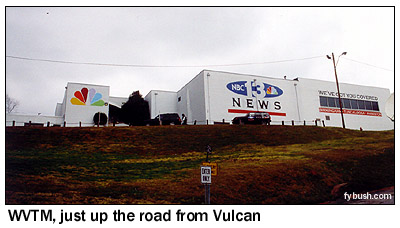
Next door to WBRC's Southern-style studio (look familiar? WBRC, like Atlanta's WAGA, was once a Storer television station, and that's how Storer built its buildings) is the big, blocky home of WVTM, channel 13. This is the oldest station in town, having signed on a few months before WBRC as WAFM-TV, a CBS/ABC affiliate. WAFM became WABT in 1953, then picked up NBC when WBRC went to CBS in 1954. And in 1958, it changed calls to match its sister AM station, Birmingham's oldest radio station, WAPI (1070), becoming WAPI-TV. (At the same time, the former WAFM-FM became WAPI-FM on 94.5; it's now WYSF and is still on the channel 13 tower!) WAPI-TV became WVTM in 1980, "TM" for Times Mirror and "V" for Vulcan, as in the huge statue that perches on a tall pillar just down the road from channel 13. (He was off the pillar, being restored, when we visited).
By 1994, WVTM was owned by a company called Argyle Broadcasting, which was eventually absorbed into New World Broadcasting - which already owned WBRC (and which would eventually be purchased by Fox, triggering all those affiliation changes in Detroit, Kansas City, St. Louis and so on) and thus couldn't hang on to two stations in the market. So in 1996, WVTM (and sister station KNSD in San Diego) were sold to NBC itself, creating two owned-and-operated stations up here above Red Mountain.
One last bit of Red Mountain trivia: From the city side of the mountain, the big red "WBRC" letters are still a landmark, overlooking town from the back of the WBRC facility. We're told that WBRC and WAPI once shared the sign: it would flash back and forth between "6 WBRC" and "13 WAPI," with half the sign on the WBRC property and half on the WAPI property! Now that's cooperation...
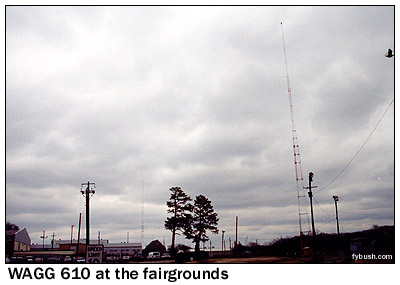 But enough about
TV - how about some radio? There's AM here as well, and for a
long time, the big AM top-40 voice in town was WSGN ("South's
Greatest Newspaper", for former owner the Birmingham
News) on 610, operating from two widely-spaced towers on
the Alabama State Fairgrounds, southwest of downtown.
But enough about
TV - how about some radio? There's AM here as well, and for a
long time, the big AM top-40 voice in town was WSGN ("South's
Greatest Newspaper", for former owner the Birmingham
News) on 610, operating from two widely-spaced towers on
the Alabama State Fairgrounds, southwest of downtown.
This is where Rick Dees got his first big break (in 1973), among other radio notables - but like so many top-40 AMs, WSGN couldn't survive the onslaught from FM in the eighties, segueing to AC and then adult standards. In later years, the station became WZZK(AM), simulcasting the FM, then WEZN(AM) (which is why the 99.9 in Bridgeport, Connecticut is now WEZN-FM); today it does gospel music as WAGG.
A few miles away, heading south on US 11 towards Bessemer, are the two tall towers of WJOX on 690. Today, it's Citadel's all-sports outlet, but back in the day this was the other big rocker in town, WVOK. It was a daytimer then, too (albeit a 50 kW daytimer) - but now it has 500 watts of power after dark, for whatever that's worth. (It's been heard way up here at sunset, just before dropping power, back when Montreal was silent on 690.)
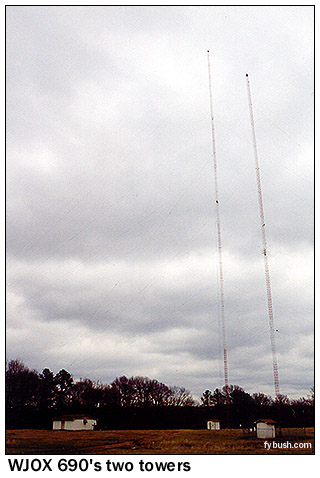
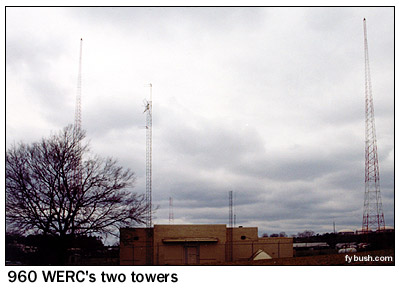
That does it for south of town; from here we headed for the hills northwest of downtown, where US 78 (the future I-22?) strikes out towards Elvis country, Tupelo and Memphis. (In the process, we skip over a whole bunch of minor Birmingham AMs, mostly non-directional and mostly religious; hey, you can't see everything!)
Just north of I-20 we find Clear Channel talker WERC (960), the former WBRC(AM), with a history that goes clear back to the 1920s. It split from the TV station in the early seventies, changing calls slightly in the process, but it's been using this two-tower site far longer than that. WERC, too, was a top-40 player in the market in the seventies, switching to news-talk in the early eighties.
Continuing up US 78, we turn off at Forestdale, climbing the little roads of Sunset Mountain to yet another two-tower site, that of WAPI (1070). WAPI has a very long history, going back to its days as Alabama's first radio station, licensed to Auburn and operated by the university there (then known as "Alabama Polytechnic Institute." WAPI moved to Birmingham in 1929, and it's not hard to believe that this site dates back just that far.
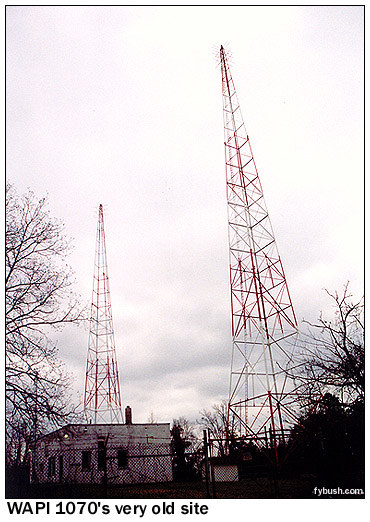 Look at those towers:
could there once have been a wire dipole strung between them?
And what are those spiky things near the top of both sticks?
We weren't sure, but they were certainly different from your
run-of-the-mill directional array.
Look at those towers:
could there once have been a wire dipole strung between them?
And what are those spiky things near the top of both sticks?
We weren't sure, but they were certainly different from your
run-of-the-mill directional array.
(WAPI, by the way, is owned by Citadel these days, running talk in competition with WERC. With 50 kW by day and 5 kW at night, it's probably the single best AM signal in the city.)
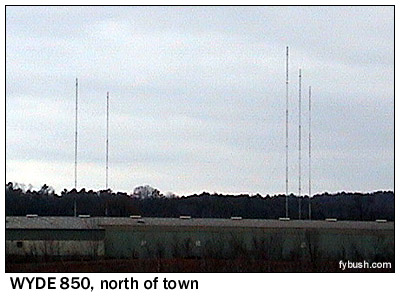
We were due in Huntsville by late that Sunday afternoon (March 3), so after WAPI we began the trek north, heading back around downtown (and passing the tower of religious WRJS 1320 along the way) and up Alabama 79. A few miles north of town, we passed our last Birmingham AM array: the five towers of WYDE (850).
This is another 50 kW daytimer with night power (1 kW), and here's some trivia for our Boston-area readers: it was once known as WILD, before Bartell bought the station in the late fifties and moved the calls up to Beantown to be installed at 1090 on the dial. WYDE then became Birmingham's first top-40, as part of a pair with Atlanta's WAKE (1340, now WALR). And yes - you bet they called them the "WYDE a-WAKE Stations"!
WYDE went country once WSGN and WVOK began challenging it in earnest; in later years it would do everything up to and including Radio Disney - and here's another irony: under that format, it changed calls for a while to WMKI. When 850 went back to WYDE in 1999, those WMKI calls went up to, yes, Boston, where they now reside at 1260 on the dial.
WYDE has been doing conservative talk under Crawford ownership for the last few years; after our visit, Crawford bought WRRS (101.1) up north in Cullman, which will pick up the talk as WYDE-FM. 850 will go gospel, taking some of the programming now heard on Crawford's WDJC (for Donald J. Crawford) 93.7, which will go fulltime Christian contemporary.
And that's probably far more than you wanted to know about radio and TV in Birmingham, isn't it?
Next stop: Huntsville; see you next week!
- Previous Site of the Week: Atlanta, Part Two
- Next Week: Huntsville, Alabama
- How can you help support Site of the Week? Click here!
- Submit your suggestions for a future Site of the Week!
